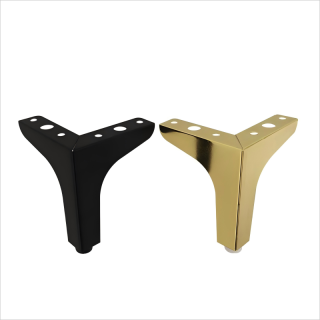Application scenarios of sofa hinges
1. Functionally-adjustable sofa: On a sofa with adjustable backrest angles, the sofa hinges play a crucial role. For instance, in a home theater sofa, viewers can adjust the backrest angle through the hinges to find the most comfortable viewing posture and enjoy a leisurely and pleasant time. There are also electric functionally-adjustable sofas. The sofa hinges work in conjunction with the electric system to enable actions such as stretching and contracting of the sofa, meeting diverse needs such as lying down and resting for people.
2. Foldable Sofa: For the foldable sofas commonly used in small-sized apartments, the sofa hinges are the core components that enable its folding function. During the day, the sofa can serve as a regular seating furniture; at night, by rotating and folding the hinges, the sofa can quickly transform into a comfortable bed, effectively saving space and enhancing the utilization rate of the space.
3. Combination Sofas: Some combination sofas are connected by sofa hinges among their modules. This design facilitates the adjustment of the sofa's shape and combination method according to different space layouts and usage requirements, enabling it to adapt to various scenarios such as family gatherings and visits from friends.
The production process of sofa hinges
1. Raw material selection: Usually, high-quality metal materials such as stainless steel and cold-rolled steel are chosen. These materials possess excellent strength, wear-resistance and corrosion-resistance, which can ensure the service life and stability of sofa hinges.
2. Forging or stamping: When using the forging process, the metal billet is heated to an appropriate temperature and pressure is applied through a mold to shape it into the desired hinge shape. This process enables the hinges to have high strength. The stamping process involves using a press and molds to stamp metal sheets into hinge components at room temperature, which results in higher production efficiency.
3. Machining: Further machining is carried out on the hinge components that have undergone forging or stamping, such as drilling, milling, and grinding operations, to precisely control the dimensions and surface roughness of the hinges, ensuring the mating accuracy between the various components.
4. Surface Treatment: To enhance the aesthetic appeal and corrosion resistance of the hinges, surface treatment is carried out. Common treatment methods include electroplating (such as chrome plating, zinc plating), painting, and electrophoretic coating. Electroplating can give the hinges a shiny metallic appearance and enhance their corrosion resistance; painting offers a variety of color options to meet different decorative requirements; electrophoretic coating can ensure uniform and firm coating, improving the wear resistance and corrosion resistance of the hinges.
5. Assembly: After machining and surface treatment, each hinge component is precisely assembled in accordance with the design requirements. During the assembly process, key parts such as springs and shafts are installed to ensure that the hinges can achieve flexible rotation and reliable positioning functions.
6. Quality Inspection: The assembled sofa hinges are subjected to rigorous quality checks, including appearance inspection, size accuracy measurement, opening and closing frequency test, and load-bearing test, etc. Only those products that pass all the tests can enter the market, ensuring that consumers can purchase reliable sofa hinges of high quality.
0
Empty!
Adjustable Iron Sofa Headrest Mechanism






